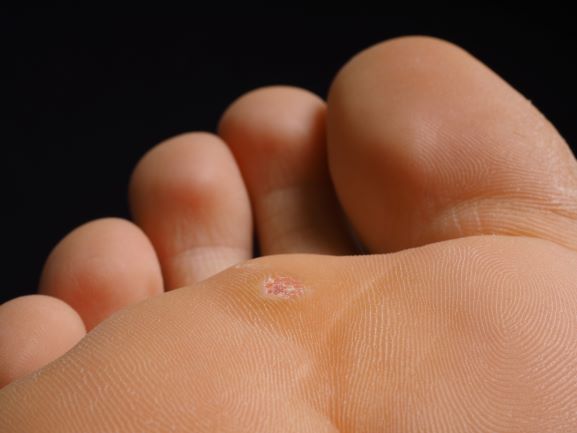While warts on your hands and other parts of your body can vary in how they look, plantar warts on your feet have a more consistent appearance.
What do Warts on Your Feet Look Like?
- They are usually round and you can mistake them for corn or calluses.
- Plantar warts are usually flat rather than raised because they are covered by the top layer of the tough skin of the sole of your foot.
- They might also have a rough, grainy surface texture.
- The little black dots near the center of the wart are the blood supply to the wart.
- Warts on the feet can occur singly or you may have them in clusters.
- They can stay small or you can get a giant plantar wart.
- Often, they appear on the heel or ball of your foot where you place your weight when standing or walking.
The Difference Between Warts and Calluses?
Warts on your feet can often look like calluses, which are thickened areas of skin. But warts have a few distinguishing features that calluses do not.
With Warts:
- They interrupt the skin lines.
- They have that unique small black “seed” dot (capillary blood supply).
- They are painful when squeezed side to side.
With Calluses:
- The skin lines continue through the hard, dead skin.
- There are no dots, no blood supply.
- They are painful when pushed on directly
What Happens When You Have Multiple Warts on the Foot?
Warts are caused by the human papillomavirus (also known as HPV) the virus will infect the epidermis which is the upper layer of skin.
Once infected:
- Multiple warts can develop on the sole of your foot.
- Multiple warts can appear as distinct warts in different spots, or they can be grouped together in a cluster, which is called a mosaic wart. A large cluster of warts can be very painful and make it uncomfortable to walk or run.
- It is also more difficult to treat a larger cluster to eliminate them.
- What is the worst symptom of a wart on the foot?
- The worst thing is the pain and discomfort.
While regular warts on the rest of the body do not usually come with too many problems, wart on the feet are a different story. It is all because of their location — the soles, heels, toes and balls of your feet. This can mean a painful reminder of their presence with every single step. It can feel either like you are walking with a rock in your shoe or it can mean a throbbing, burning sensation. Plantar warts are most common on the parts of the foot that receive the most pressure when you’re standing or walking, increasing the pressure on the wart and sending it further inward, deep into your skin.All that pressure also flattens the plantar wart. It ends up looking less like a wart and more like a callus.
Are Warts on the Feet Contagious?
Plantar Warts that appear on the feet are particularly contagious. There are several things you should remember to avoid passing on plantar warts or even to prevent picking them up in the first place:
Avoid going barefoot in public places.
- Use flip flops when you are in public showers or bathing areas and even in your own home to avoid transmission to others.
- Plantar warts can spread in warm and moist areas.
- Avoid touching and picking at a plantar wart. This can increase your risk for the virus spreading to other areas of your foot or hand.
- Keep the nails short as long fingernails are more likely to catch a wart, trapping pieces of the contagious virus underneath.
- Avoid sharing personal care products with others such as razors, towels, socks, shoes and more.
- Cover warts while they are being treated by keeping the area bandaged, changing such bandaids frequently.
- Practice good hygiene by keeping any affected area clean and dry, changing any socks frequently.
- Keep your skin healthy as this can help to fight off the HPV virus more easily. Nourish your skin both topically by caring for your skin with essential oils
products and from the inside with a healthy and nutritious diet.
How to Treat Warts on the Foot?
There are over-the-counter products that you can use. These products use salicylic acid to remove the layers of the wart slowly. You can also buy “freezing sprays” at the drugstore for plantar warts. These liquid nitrogen-containing products are designed to mimic the effects of cryotherapy at a doctor’s office. The spray works by creating a blister-like injury that sticks to the wart. Once the blister heals, the wart should go away too. To use freezing spray, dispense the product directly onto your wart for up to twenty seconds. Repeat as often and as long as necessary up to six weeks.
Natural Alternatives for the Treatment of Warts
This is H-Warts Formula which is all natural, contains no harmful additives and comes with carefully selected homeopathic ingredients. The product is applied directly to your warts using a cotton swab with only a few drops needed. H-Warts Formula begins to work quickly! The process does vary based on the size and number of warts. The warts may change in color, size and/or appearance and begin to flake away. You can expect to see results in a week or two with perhaps some stubborn warts taking a little longer.

